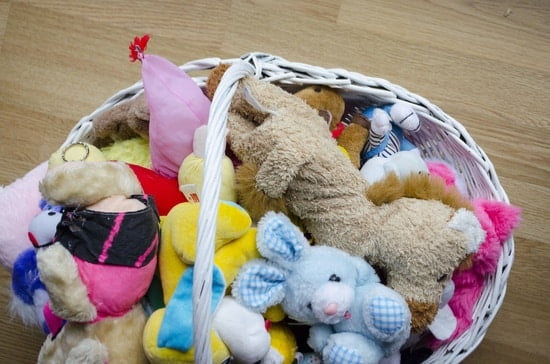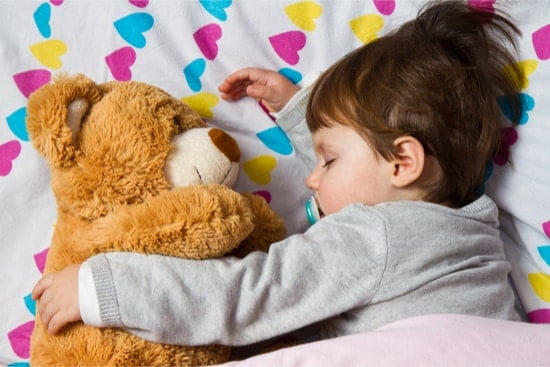Bed bugs are difficult to kill, because there are so many potential hiding places. Anywhere within six feet of a host could be their next home—somewhere that they can easily access you from at night when they need to feed on human blood.
Bed bugs can live in plush toys, but it’s unlikely. They’re fabric and offer many crevices for them to live in. However, bed bugs are more likely to choose a location underneath your mattress, where they’ll be closer to their host and less likely to be disturbed.
And if you’re thinking of treating your home for bed bugs, don’t just focus on your stuffed bears or plastic toys. If there are some, there are guaranteed to be others elsewhere, since toys would never be their first choice for a home. Treat your entire room, even your entire home, instead.
Do Bed Bugs Live in Kids’ Stuffed Toys?
Bed bugs can live in a very wide range of places. They can live inside electronics, for example, like TVs, computers or laptops. They can live in bedding, furniture, even in crawl spaces underneath or behind walls. It’s no surprise that they can, therefore, live in teddies and toys.
We should make it clear, though, that this depends on circumstance. Bed bugs have many requirements that they need to be met if they want to live in a particular place.
They need it to have a crack they can get in or something they can hide under. If there is a hole in the stuffed toy, that will give them somewhere to hide. They may also hide underneath button eyes, or anything similar to them. So, a stuffed toy would tick those boxes.
However, bed bugs also like hiding places that don’t move. That’s why they typically hide on the underside of your mattress, rather than on your comforter or under your pillow.
Over the course of the night, you kick your legs and move your pillow around, which would disturb them. The underside of your mattress is practically undisturbed, and can be for weeks on end if you don’t change your sheets regularly.
As for stuffed toys then, they’re only likely to become infested if you leave them unattended for a long time. If you pick them up, move them around or play with them, then bed bugs won’t want to live in them. They would also have to sit within six feet or so of your bed for bed bugs to want to live there, since they need a harborage that’s close to their host.
Can You Get Bed Bugs in Plastic Toys?
Plastic toys are different again. Bed bugs do generally prefer fabric over plastic. But it’s still possible for them to live in plastic toys, especially if they don’t have many alternatives.
Anything that has cracks or gaps in it for them to hide in is a good candidate for a harborage. As you can imagine, most plastic toys fit that description: toy musical instruments, action figures, toy cars and more. Even if they don’t have gaps for them to hide in, they can hide underneath.
In particular, bed bugs will infest things that you leave underneath a bed. If your child’s bed has bed bugs in it, and you store all of their toys underneath it, then there’s a good chance that there will be some bed bugs hiding in among the carnage. To avoid that happening, it’s best to keep your child’s room organized, and store their things in plastic bins.

Bugs That Live in Stuffed Animals
Bed bugs aren’t the only bugs that can live in stuffed animals.
Cockroaches
Cockroaches enjoy finding enclosed hiding spaces. While they wouldn’t pick a stuffed animal as their first port of call, they will hide there if there is a large infestation.
Fleas
If you spot tiny bugs on stuffed animals, they’re likely fleas. While the fleas won’t think that the stuffed animal is an animal, they do live in bedding and fabrics, so a stuffed toy is perfect for them.
They’ll then hop onto their host whenever they come near, e.g., when your child cuddles their toy. Killing fleas on stuffed toys is much the same as killing bed bugs, which we’ll cover in a moment.
Carpet Beetles
Carpet beetles also like old fabrics, so aside from bed bugs, these are the most likely inhabitants of your stuffed toys.
These beetles look like ladybugs, but have different colors and patterns. Some are pure black and shiny, while others are a mottled brown. Here’s how to tell bed bugs and carpet beetles apart.
Both kinds are the same size and shape as ladybugs. They eat dust and dirt, as well as fabric fibers, so they would have good reason to live on a stuffed toy.
How Do You Get Rid of Bed Bugs on Toys?
To get rid of bed bugs on toys, there are many approaches you could take. Which one you pick depends on what your toys are made from, and what you can afford.
Washing Machine or Dryer
Stuffed toys can generally be laundered or dried. Putting one through a spin cycle will easily kill all of the bed bugs on it or inside it.
They don’t like heat, and they especially don’t like water. Over the course of an hour, every single bed bug will be killed. To make sure you don’t spread any bed bugs around, follow this procedure:
- Bag the stuffed toys and seal them up. This is essential so that you don’t spread the bed bugs around your home. You can tie the bag at the top, hold it shut, or whatever you like—just so long as it can’t open and spill its contents on the ground.
- Then take the bag directly to your washing machine/dryer. Open the bag directly into the washing machine or dryer. Add powder/softener or whatever else you need to add, and shut the door.
- Wash or dry the stuffed toys for an hour on high heat.
- Dispose of the bag in the trash outdoors, not indoors. If you dispose of it indoors, any bed bugs in there may be able to infest other parts of your house.
- Once the cycle is over, check the stuffed toys and the machine to see if you can spot any dead bed bugs. There won’t be any left alive, but if you spot dead ones, you’ll know you were right when you thought they were infested.
If you need to clean a basic stuffed toy, check their care tag. It will tell you whether you can launder them or put them in the dryer. If you can, you’re good to go! The problem is that you can’t do this with plastic toys. If you suspect you have bed bugs in your plastic toys or electronics, you’ll have to try a different method.
Does Bagging and Sealing Kill Bed Bugs?
If you do have plastic toys and electronics with bed bugs in them, you should try bagging and sealing them. Bagging your things won’t kill bed bugs straight away, but it does stop the bed bugs inside from being able to give you itchy bites. The more things you bag, the fewer bites you’ll get.
Most effective is storing your things in a plastic bin. While bed bugs can’t bite their way out of a bag, there are likely to be rips and tears in one. Use a strong plastic bin instead, one which won’t crack, and there will be no way for the bed bugs to get out.

You then leave the bin, preferably in a place where it can get very hot or very cold. This will kill the bed bugs faster than if you keep them at a temperature that’s comfortable for them.
If you want your things back, though, it will take a while. Bed bugs can live without food and water for an entire year, or more if they’ve recently fed. It would be quicker to try treating your things with something than just leaving them.
You could try using a small amount of pesticide spray before sealing your things away. If you do, don’t breathe the fumes in directly the next time you open the box.
Pest Control for Bed Bugs
The best way of treating bed bugs is with heat. But if all you do is get rid of the bed bugs in your stuffed toys, we can tell you right now: you’re not going to have a fun time.
That’s because the bed bugs underneath your mattress, in your clothes or even in the walls will still be there. If they want to, they’ll re-infest your stuffed toys as soon as they get the chance.
That’s why you should opt for whole-house heat treatment. Contact a pest control operative, and they’ll be able to do the work for you.
Essentially, they seal the entry/exit points of your house and leave a powerful heater running for six hours or more, over the course of a day.
The idea is to get the temperature to at least 122 degrees, which is the point at which bed bugs die. The point of the long treatment time is to get the heat to penetrate furniture and bedding.
You could also ask them to use pesticides. Pesticides are toxic substances known to kill insects. The PCO will spray them around your home thoroughly, in every area where there may be bed bugs.
It kills on contact, and any that don’t come into immediate contact with it will either die later on or be repelled. People have used pesticides to successfully control bed bugs for decades now. In fact, we nearly wiped them out until the number of infestations started growing again.
Heat treatments are better than pesticides. According to Parasites and Vectors, bed bugs are becoming progressively more immune to common pesticides like permethrin.
This occurs because of repeated exposure, and the one or two bed bugs that are naturally immune because of a mutation breed and create more successful infestations. However, they haven’t yet become ‘immune’ to high heat.
The only problem with heat treatments is that they’re expensive. Pest control operatives are quite expensive anyway. But heat treatments require special equipment that most PCOs don’t have.
Those that do are likely to charge quite a lot for the service. Ask around and make some calls to see where you can find the cheapest prices.
Do You Have to Throw Away Infested Things?
If you’ve tried everything you can, but the bed bugs just won’t go away, then you’ve no choice left. You have to throw them away. This is the quickest way to get rid of bed bugs, by far.
Again, you should bag your things and seal them before throwing them away. Otherwise, there’s a chance they could infest other parts of the home or even come back indoors from outside.
And if you think that’s drastic, it’s not a patch on what some people do. Most people who endure bed bug infestations (those that last for years) end up having to move.
They leave everything behind and start fresh, not bringing anything with them if it could potentially harbor bed bugs. Of course, it’s expensive, and it takes a lot of time, but your health is more important than anything else.

